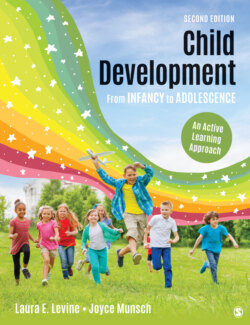Читать книгу Child Development From Infancy to Adolescence - Laura E. Levine - Страница 241
На сайте Литреса книга снята с продажи.
The Baby’s Birth Experience
ОглавлениеYou probably have heard stories about labor and delivery from the perspective of the mother, but have you ever wondered how the baby experiences birth? It might seem pretty traumatic. The baby is pushed through the birth canal, with uterine contractions intermittently causing oxygen deprivation. The newborn rapidly goes from a warm, quiet, and dark prenatal environment into a bright, noisy, and cold postnatal world. Fortunately, babies are physiologically well prepared to handle the stress of being born. For one thing, the skull of a baby is composed of separate plates that can overlap and compress during the birth process, allowing the head to elongate so it can fit through the birth canal. The mother’s production of stress hormones during labor triggers the production of stress hormones in the baby, which prepares the lungs to begin breathing, sends additional blood to the baby’s brain and vital organs, and makes the baby alert right after the birth (Weiss, 2014).
As soon as the baby’s head is delivered, the doctor or midwife uses a rubber syringe to clear the mouth and air passages. After the baby’s body emerges, the umbilical cord is clamped and cut after it stops pulsing. The baby’s weight, head circumference, and length are measured, and a few drops of an antibiotic are placed in the baby’s eyes to prevent infection from any organisms that were in the birth canal (Ben-Joseph, 2014).
The baby’s overall condition is assessed using the Apgar Scale at 1 minute and again at 5 minutes after birth. The newborn receives 0, 1, or 2 points each for its Activity level, Pulse, Grimace (a reflexive response to stimulation such as a mild pinch), Appearance, and Respiration. Newborns in the range of 7 to 10 points receive routine care and are reassessed at 5 minutes. The baby will be kept warm and placed on the mother’s stomach for some skin-to-skin contact or in her arms so mother and baby can meet for the first time. An Apgar score in the range of 4 to 6 indicates that some intervention is needed. This might be some additional suction to help the baby breathe, massage, or the administration of oxygen. A score of 3 or less means some immediate lifesaving intervention is needed (Bregman, 2005).
Apgar Scale: An assessment of a newborn’s overall condition at 1 minute and 5 minutes after birth that is based on the newborn’s activity level, pulse, grimace, appearance, and respiration.
After they are given a bath and wrapped in a blanket, newborns receive a vitamin K shot to help their blood clot properly. Before they leave the hospital, a few drops of blood will be drawn to test for PKU and other genetic and biochemical disorders (March of Dimes, 2008).
